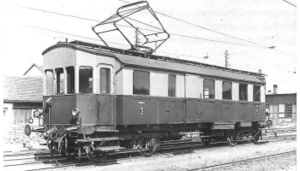LAG No. 772
| LAG No. 772 | |
|---|---|
|
Company photo of LAG 772
|
|
| Numbering: | LAG No. 772 DR ET 185 01 DB ET 185 01 |
| Number: | 1 |
| Manufacturer: | mechanical: MAN electrical: SSW |
| Year of construction (s): | 1905 |
| Retirement: | Early 1960s |
| Axis formula : | (1A) (A1) |
| Genre : | CPw 4L |
| Gauge : | 1435 mm ( standard gauge ) |
| Length over buffers: | 14,750 mm |
| Trunnion Distance: | 9,000 mm |
| Total wheelbase: | 11,500 mm |
| Service mass: | 24,700 kg |
| Friction mass: | 13,400 kg |
| Top speed: | 40 km / h |
| Continuous output : | 90 kW (122 hp) |
| Starting tractive effort: | 27 kN |
| Wheel diameter: | 1,000 mm |
| Power system : | 650 V = |
| Power transmission: | Overhead line |
| Number of traction motors: | 2 |
| Seats: | 44 |
| Classes : | 3. |
The LAG no. 772 was a four-axle electric motor coaches of Lokalbahn AG (LAG) for the operation on the branch line Meckenbeuren-Tettnang .
After the nationalization of the LAG , it was taken over by the Deutsche Reichsbahn and named ET 185 01 . The railcar already shows similarities to the DR series ET 85 , which appeared 20 years later. It was still taken over by the Deutsche Bundesbahn and served until the early 1960s. The vehicle is no longer available today.
history
The LAG operated several branch lines in southern Germany, which were already used electrically and with railcars before 1900. With the increasing volume of traffic after the turn of the century, the LAG No. 360 and 361 and LAG No. 501 to 505 between Meckenbeuren and Tettnang were no longer sufficient.
That is why this vehicle was created as another four-axle vehicle. It was manufactured by MAN in the mechanical and SSW in the electrical part. This railcar always ran on the Tettnang route, at times it was used there as a tow car in freight traffic. Like the other vehicles, it was located at the Friedrichshafen depot after it was taken over by the Reichsbahn .
The vehicle was used until the early 1960s, it is no longer available today.
construction
Compared to LAG No. 501 to 505 , the railcar had an exterior that was similar to the ET 85, which appeared 20 years later. Otherwise, the vehicle structure was like the LAG No. 501 to 505 : between a smaller (originally 2nd class with eight seats) and a larger passenger compartment (originally 3rd class with 36 seats) was a luggage compartment with a large sliding door. In older vehicle registers the railcar was listed as CPw 4 ET Wü-06 . The entry areas, which were also the driver's cabs, were designed to be closed from the start. In a later conversion, the car was designed as a single-class 3rd class car.
The underframe of the car body was a riveted steel construction, the frame of the car body was made of wood and the outside was clad with sheet metal.
The inner axles of each bogie were each driven by a traction motor suspended in a pawl bearing design . The current was first drawn from a pantograph with a roller, later it was adapted to the more modern requirements.
literature
- Horst J. Obermayer: Paperback German railcars. Franckh'sche Verlagshandlung, Stuttgart 1973. ISBN 3-440-04054-2 .
- Dieter Bäzold, Brian Rampp, Christian Tietze: Electric railcars of the German railways , Volume 1.2, Alba Verlag, Düsseldorf 1997, ISBN 3-87094-169-3 .
Web links
- Website from the locomotive magazine about the ET 184.4
- Photo of the parked ET 185 01 1962 on the Joachim Schmidt Railway Foundation
Individual evidence
- ↑ Internet site about the LAG railcars on Lok-Magazin
- ↑ Bäzold / Rampp / Tietze: Electric Railcar German railways , Alba Verlag, Dusseldorf 1997, ISBN 3-87094-169-3 , page 230
- ↑ Horst J. Obermayer: Paperback German Triebwagen. Franckh'sche Verlagshandlung, Stuttgart 1973. ISBN 3-440-04054-2 , page 111
